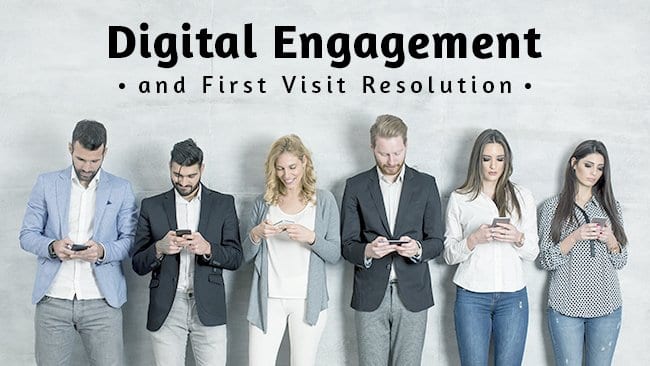
First contact resolution (FCR) is undoubtedly the first prize for any organization that operates a contact center. By taking care of whatever challenge the customer faces the very first time they make contact, you not only make sure that the individual customer is kept happy but more crucially, you instill a sense of loyalty going forward – and in the modern world, loyalty is a rare thing indeed.
Of course, we have moved beyond the contact center of a decade ago, where voice was the critical channel of contact. Today, digital resources abound, and these can be added to the customer journey in order to improve FCR, through the enablement of self-service and the simple improvement of offering the customer contact through the channel of their choice. The addition of digital channels will increase the convenience factor for customers as well, further improving their satisfaction with your contact center.
Digital is, in fact, rapidly becoming the preference for customers. After all, today’s customers spend a lot of time online and are digitally very knowledgeable, so it goes without saying that an increasing number seek contact via channels such as social media, the Internet (Web chat) and their smartphones. Ironically, the latter is still seen by them as a digital, rather than a voice, platform.
In particular, the younger generation of consumers – the so-called ‘Millennials’ – entering the market are especially comfortable with technology, with this generation only using the phone as a last resort. They are far more comfortable using channels like e-mail, Web chat, social media and various self-service channels. This means that the modern contact center simply has to incorporate digital channels into its customer engagement strategy if it aims to maintain high rates of FCR and the attendant customer satisfaction.
Digital Engagement increase FCR
The key to using digital engagement to generate increasing FCR is to ensure customers are offered a friction less, easy and immediate journey, using the channels of their choice. This must be done by providing a connected omnichannel journey; it also means that agents can no longer simply be skilled in voice engagements – they need to be multi-skilled in order to assist customers in the numerous non-voice engagement channels that are now coming to the fore.
Naturally, providing an omnichannel experience creates the additional challenge of requiring high levels of integration in order to ensure that customers receive a consistent service across these multiple digital channel offerings.
Remember that an increasing number of your customers are likely to utilize more than one of these digital channels to complete a single inquiry, which means that the experience has to be consistent, regardless of the different media used. Ideally, such interactions should be completely frictionless for the customer.
The other thing to think about in respect of digital channels is that many customers enjoy this option because it offers far greater self-service potential and thus gives them the opportunity to ‘do it for themselves,’ as opposed to having to make contact with an agent to assist them. Not only can the feel-good factor that springs from solving your own problems further improve the customer experience, but at the same time, it frees up agents to tackle potentially more complex problems that other customers may have. It is a true win-win situation.
Even when a customer chooses to deal with an agent, rather than attempting a self-service option, the digital channels offer them a much-improved customer experience. After all, chatting to an agent via a Web call not only provides a more personal touch, but it is also often simpler and easier than picking up a phone, an option that may very well result in them sitting on hold for a long period.
A survey by McKinsey¹ has noted that the customer satisfaction levels of those who completed their service journey via a traditional means (i.e., voice) only and those who incorporated both digital and voice were similar, at around 57%. However, for those who both started and ended the journey via digital platforms, the satisfaction rating was some 19 percentage points higher – clear evidence that a pure digital journey can drive higher customer satisfaction.
Importance of Digital Channels
Since the importance of digital channels to FCR is clear, the next step that contact centers need to consider is how to continue improving on such services. In this regard, customer feedback is obviously enormously beneficial.
Furthermore, data and analytics offer another route to gaining further insight into the wants and needs of customers. In fact, analytics is viewed by many in the industry as the single biggest factor that will impact on contact centers over the next few years.
The effective use of data and analytics will enable contact centers to shift their mindsets from mass service to mass personalization. Using big data and analytics tools will lead to a better understanding of the intricacies of individual transactions. Furthermore, this will be able to deliver even greater context to customer behavior over multiple contacts and channels.
Greater understanding of the customer will lead to improvements in the digital channels themselves, as well as enabling the organization to address customer issues and to shape their experiences. This, in turn, will enrich the overall engagement and deliver greater value for both the customer and the organization.
If businesses can increase customer satisfaction substantially by delivering FCR through digital channels, then it goes without saying that the proactive engagement of customers can only improve things further. Not only should this lead to even fewer contacts being made with the contact center, but it should also boost customer satisfaction.
After all, by proactively reaching out to customers before they actually need to call the contact center, businesses put themselves in a position to reduce both their costs and potential customer frustrations. Obviously, such a strategy would require the organization to determine what types of issues they can assist customers with in advance – again, analytics may assist in this regard – but such knowledge will allow you to tackle certain customer challenges even before they are aware of these themselves.
Any situation that results in eliminating a customer’s need to make contact with your center is going to improve customer satisfaction. Moreover, even the customer finds themselves in a position where they still need to make contact after your proactive messages, in all likelihood they will be far happier and the odds of ensuring FCR will be greatly improved.
All of the above serves to highlight that digital is undoubtedly the way of the future for the contact center. It delivers enormous benefits to both the organization and the customer, as it offers greater opportunities for FCR and the increased customer satisfaction that goes along with this. Although managing these channels and integrating them is likely to cause contact centers some headaches, it is well worth it, provide you have as your ultimate goal the aim of ensuring that the customer’s desired outcome is achieved through an effortless experience.
[About the author] Dylon Mills is the Director of Marketing Content Strategy & Development at Jacada. As such, Dylon’s main responsibilities are to strategize, create and deliver content for Jacada’s product portfolio that align with the global Go-To-Market strategy, corporate positioning, and marketing campaigns. Dylon’s prior work experience includes Product Management at one of the top Fortune 500 Technology companies, Symantec Corporation. Outside of work, Dylon enjoys problem-solving and any project that includes building/tinkering with tools. Dylon holds a BS Consumer Economics from the University of Georgia.
Dylon Mills is the Director of Marketing Content Strategy & Development at Jacada. As such, Dylon’s main responsibilities are to strategize, create and deliver content for Jacada’s product portfolio that align with the global Go-To-Market strategy, corporate positioning, and marketing campaigns. Dylon’s prior work experience includes Product Management at one of the top Fortune 500 Technology companies, Symantec Corporation. Outside of work, Dylon enjoys problem-solving and any project that includes building/tinkering with tools. Dylon holds a BS Consumer Economics from the University of Georgia.
1 http://www.mckinsey.com
)